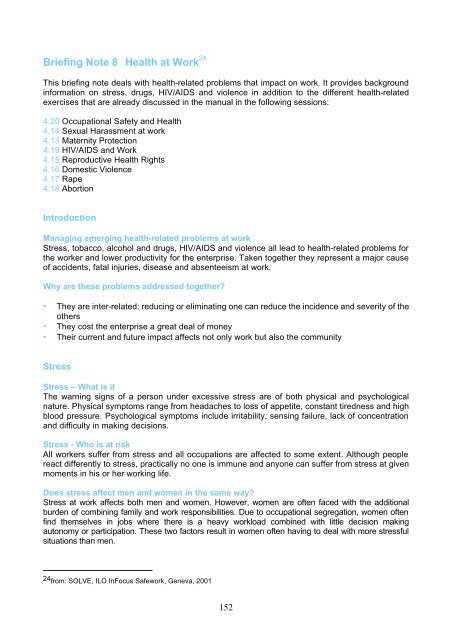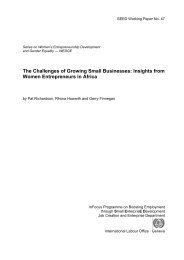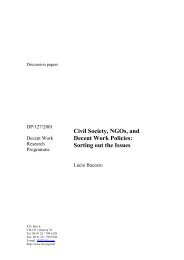manual: women workers' rights and gender equality - International ...
manual: women workers' rights and gender equality - International ...
manual: women workers' rights and gender equality - International ...
You also want an ePaper? Increase the reach of your titles
YUMPU automatically turns print PDFs into web optimized ePapers that Google loves.
Briefing Note 8 Health at Work 24<br />
This briefing note deals with health-related problems that impact on work. It provides background<br />
information on stress, drugs, HIV/AIDS <strong>and</strong> violence in addition to the different health-related<br />
exercises that are already discussed in the <strong>manual</strong> in the following sessions:<br />
4.20 Occupational Safety <strong>and</strong> Health<br />
4.14 Sexual Harassment at work<br />
4.13 Maternity Protection<br />
4.19 HIV/AIDS <strong>and</strong> Work<br />
4.15 Reproductive Health Rights<br />
4.16 Domestic Violence<br />
4.17 Rape<br />
4.18 Abortion<br />
Introduction<br />
Managing emerging health-related problems at work<br />
Stress, tobacco, alcohol <strong>and</strong> drugs, HIV/AIDS <strong>and</strong> violence all lead to health-related problems for<br />
the worker <strong>and</strong> lower productivity for the enterprise. Taken together they represent a major cause<br />
of accidents, fatal injuries, disease <strong>and</strong> absenteeism at work.<br />
Why are these problems addressed together?<br />
• They are inter-related: reducing or eliminating one can reduce the incidence <strong>and</strong> severity of the<br />
others<br />
• They cost the enterprise a great deal of money<br />
• Their current <strong>and</strong> future impact affects not only work but also the community<br />
Stress<br />
Stress – What is it<br />
The warning signs of a person under excessive stress are of both physical <strong>and</strong> psychological<br />
nature. Physical symptoms range from headaches to loss of appetite, constant tiredness <strong>and</strong> high<br />
blood pressure. Psychological symptoms include irritability, sensing failure, lack of concentration<br />
<strong>and</strong> difficulty in making decisions.<br />
Stress - Who is at risk<br />
All workers suffer from stress <strong>and</strong> all occupations are affected to some extent. Although people<br />
react differently to stress, practically no one is immune <strong>and</strong> anyone can suffer from stress at given<br />
moments in his or her working life.<br />
Does stress affect men <strong>and</strong> <strong>women</strong> in the same way?<br />
Stress at work affects both men <strong>and</strong> <strong>women</strong>. However, <strong>women</strong> are often faced with the additional<br />
burden of combining family <strong>and</strong> work responsibilities. Due to occupational segregation, <strong>women</strong> often<br />
find themselves in jobs where there is a heavy workload combined with little decision making<br />
autonomy or participation. These two factors result in <strong>women</strong> often having to deal with more stressful<br />
situations than men.<br />
24 from: SOLVE, ILO InFocus Safework, Geneva, 2001<br />
152

















